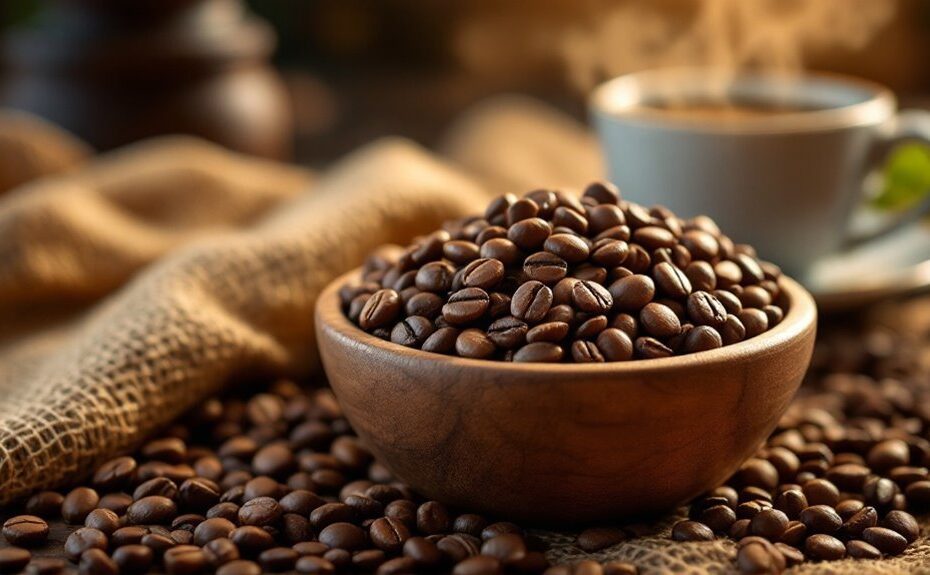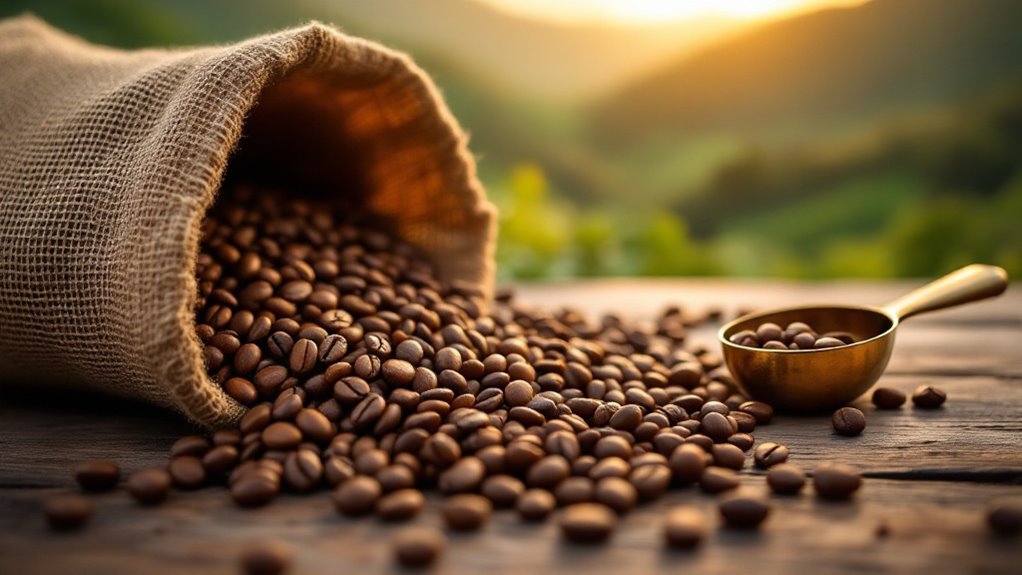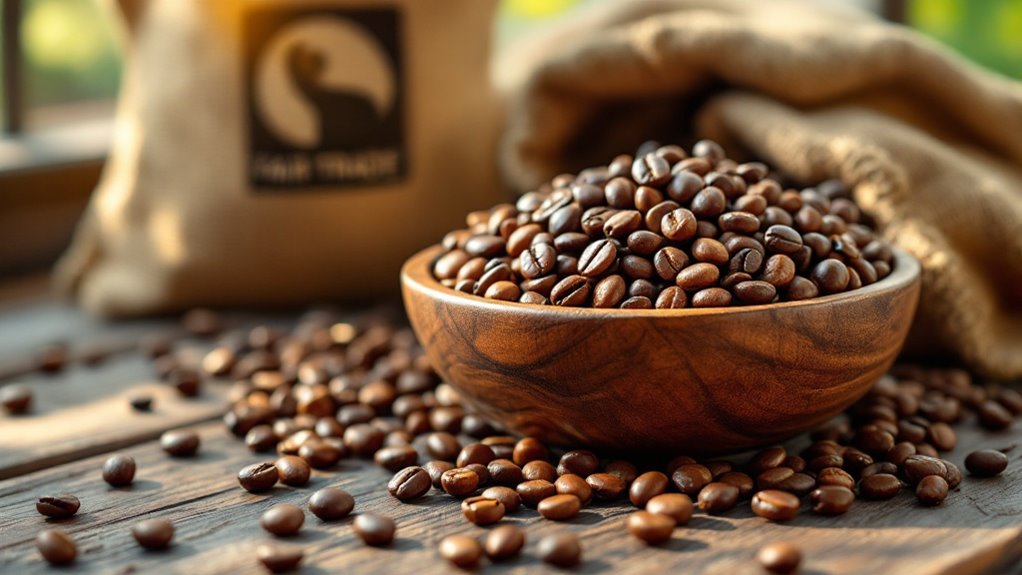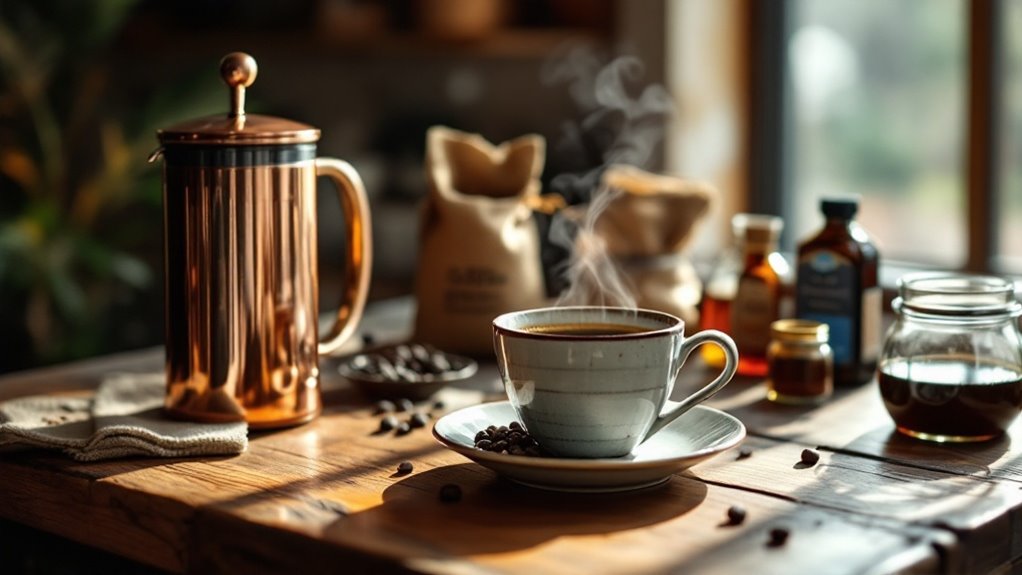







You might've stumbled upon a bag of coffee beans that smelled incredible but tasted underwhelming—coincidentally, that's often the first clue you're not matching the beans to your preferences. Choosing the best coffee for your taste isn't just about grabbing what's popular; it's about understanding how varietals, origins, and roast levels shape the flavors you love. Do you crave bright, fruity notes or a deep, smoky richness? The answer lies in a few key decisions, but there's more to uncover about how freshness, grind size, and brewing methods can elevate your cup. What's your next step?
Key Takeaways
- Identify your flavor preference: fruity, floral, nutty, chocolatey, or bold and bitter, based on bean varietals and regional profiles.
- Choose roast level: light for bright, acidic notes; medium for balanced flavors; dark for smoky, bold profiles.
- Decide between single-origin (unique regional flavors) or blends (balanced, versatile profiles) based on your taste preferences.
- Ensure freshness by buying whole beans, storing them properly, and grinding them to match your brewing method.
- Look for certifications like Fair Trade, organic, or Rainforest Alliance to ensure ethical sourcing and quality.
Understand Coffee Bean Varietals
When choosing coffee beans, understanding the varietals is essential, as each type brings distinct flavors, aromas, and characteristics to your cup. Arabica beans, grown at higher elevations, dominate the market with their smooth, complex profiles and bright acidity. If you prefer a bold, bitter kick, robusta beans deliver nearly double the caffeine and a thicker crema, making them ideal for espresso. For something truly unique, seek out liberica beans, which are rare and celebrated for their fruity, floral, and woody notes. Excelsa, a liberica variety, adds tart, nutty undertones but is harder to find. Each varietal reflects its origin and cultivation, so exploring arabica, robusta, and liberica lets you discover the depth and diversity coffee has to offer.
Decide Between Single Origin and Blends
When choosing between single-origin and blends, consider flavor complexity: single-origin highlights unique regional taste profiles, while blends balance multiple origins for a harmonious cup. Single-origin offers a seasonal, terroir-driven experience, showcasing distinct notes like fruit or florals, whereas blends prioritize consistency and versatility, excelling in espresso or milk-based drinks. Your preference depends on whether you crave the uniqueness of a specific region or the reliable, well-rounded flavor of a crafted blend.
Flavor Complexity Comparison
If you're deciding between single-origin coffee and blends, understanding their flavor complexity is key. Single-origin beans showcase a distinct flavor profile tied to their specific region, offering nuanced tasting notes like fruity, floral, or earthy tones. These coffees highlight the purity of their terroir, making them ideal for exploring unique, location-specific characteristics. Blends, on the other hand, combine beans from multiple regions to craft a complex flavor that's balanced and versatile. They often deliver a fuller body and harmonious taste, with consistent year-round quality. While single-origin coffees emphasize individuality, blends excel in creating a well-rounded experience. Your choice depends on whether you crave the singular depth of a single origin or the layered richness of a blend.
Regional Taste Profiles
Exploring regional taste profiles can help you decide whether single-origin or blended coffee suits your palate. African coffees, like Ethiopian or Kenyan, often deliver bright, fruity, and floral notes with vibrant acidity, perfect for those who crave complexity. Central and South American coffees, such as Colombian or Guatemalan, typically offer balanced, nutty, and chocolatey flavors with medium acidity, ideal for a smooth, approachable cup. Asian-Pacific coffees, like Sumatran or Indonesian, lean toward earthy, spicy, and full-bodied profiles with low acidity, appealing to fans of bold, rich brews. Single-origin coffees highlight these distinct regional characteristics, letting you explore unique flavors. Blends, on the other hand, combine beans from multiple regions to create harmonious, versatile profiles, often suited for espresso or milk-based drinks.
Consistency Vs Uniqueness
Single-origin coffees let you experience the distinct flavors tied to a specific region, offering a taste of its unique terroir—soil, climate, and altitude. With Single Origin Coffee, you'll uncover nuanced profiles like Ethiopian beans' fruity brightness or Colombian beans' nutty richness. However, if you crave a consistent flavor profile, Blends are your go-to. They combine beans from multiple regions to balance acidity, body, and sweetness, making them ideal for espresso or milk-based drinks. While single-origin highlights terroir, blends focus on harmony and complexity. Blends are often more affordable and widely available, whereas single-origin beans can be pricier due to their limited production. Experiment with both to decide whether you value uniqueness or consistency in your cup.
Explore Roast Levels and Flavor Profiles
Light roasts highlight the bean's natural flavors, showcasing bright acidity and floral or fruity notes, perfect for a vibrant morning cup. Dark roasts, on the other hand, emphasize bold, smoky, and bitter profiles, with lower acidity and an oily surface that suits richer, more intense brews. Understanding these roast levels helps you match your coffee to the flavors and moments you crave.
Light Roast Characteristics
When you choose light roast coffee, you're opting for a brew that's vibrant and complex, with flavors that reflect the bean's natural profile. Light roast coffee is roasted at lower temperatures, preserving its original flavors and higher acidity, which gives it a bright, lively character. You'll often notice tasting notes like citrus, berries, or floral hints such as jasmine, showcasing the bean's inherent qualities. The beans have a dry surface with no visible oil, as the roasting process doesn't break down their structure enough to release oils. Light roasts also retain the most caffeine, making them ideal for those seeking a stronger kick. They shine in brewing methods like pour-over or drip coffee, where their delicate, nuanced flavors can truly stand out.
Dark Roast Flavor Profiles
Dark roast coffee, with its bold and smoky flavor profile, is a favorite for those who crave intensity and depth in their cup. You'll notice rich notes of chocolate, caramel, and toasted nuts, balanced by a slightly bitter taste that lingers on your palate. The extended roasting process reduces acidity, creating a heavier body and oily surface that enhances the coffee's rich mouthfeel and robust aroma. While dark roasts like French Roast or Italian Roast are often associated with espresso, they also shine in milk-based drinks, where their deep flavors complement creamy textures. Keep in mind, the longer roasting time slightly reduces caffeine content, but the trade-off is a cup that's bold, complex, and deeply satisfying for those who love a strong, smoky brew.
Prioritize Freshness and Proper Storage
To guarantee your coffee beans deliver the best flavor, freshness and proper storage are non-negotiable. Always seek out freshly roasted beans, as their peak flavor lasts only 2-4 weeks post-roasting. Check the roast date on the packaging and aim for beans roasted within the last 3 weeks to maintain quality. Store your beans in an airtight container, shielding them from light, heat, and moisture, which can degrade their aroma and taste. Avoid refrigerating or freezing them, as condensation compromises their integrity. Whole beans retain freshness far longer than pre-ground coffee, which loses its vibrant flavor almost immediately after grinding. By prioritizing freshness and proper storage, you'll reveal the full potential of your quality beans, guaranteeing every cup is a masterpiece.
Consider Sustainability and Ethical Sourcing
While savoring the rich flavors of your coffee, it's worth considering the journey those beans took to reach your cup. Opt for Fair Trade-certified coffee to guarantee farmers earn fair wages and work in ethical conditions. Choose USDA-certified organic coffee to support sustainable farming practices that avoid harmful pesticides and protect ecosystems. Look for Rainforest Alliance certification, which promotes biodiversity and responsible land use. Direct trade options are also excellent, as they foster transparency and stronger relationships between roasters and farmers. Additionally, prioritize brands with carbon-neutral initiatives to reduce environmental impact. By selecting ethically sourced and sustainably grown coffee, you're not only enhancing your cup but also supporting communities and preserving the planet for future generations.
Identify Your Preferred Flavor Profile
If you're exploring the world of coffee, identifying your preferred flavor profile is essential to crafting a cup that truly resonates with your palate. Start by considering the taste you enjoy most—bright and acidic, smooth and balanced, or bold and intense. Light roasts often deliver floral, fruity, or citrusy notes, while medium roasts bring out chocolate, nutty, or caramel flavors. Dark roasts lean toward smoky, bitter, or toasted profiles. Coffee varieties also play a key role: African beans like Ethiopian or Kenyan offer vibrant, berry-like flavors, while Central and South American coffees, such as Colombian or Brazilian, tend to be nutty and sweet. Understanding these distinctions helps you narrow down the flavor spectrum and select beans that align with your preferences.
Choose the Right Grind for Your Brewing Method
Once you've identified your preferred flavor profile, selecting the right grind size for your brewing method is essential to revealing the full potential of your coffee beans. For French Press or cold brew, use a coarse grind to allow slower extraction and achieve a fuller body. Drip coffee makers and pour-over methods thrive with a medium grind, balancing flavor clarity and extraction. Espresso machines demand a fine grind to guarantee proper pressure and produce a rich, concentrated shot. If you're brewing Turkish coffee, opt for an extra-fine grind to create a thick, intense brew. Matching your grind size to your brewing method secures ideal extraction, preventing over- or under-brewing. Precision in grind size transforms your coffee experience, releasing the nuanced flavors your beans hold.
Experiment With Different Growing Regions
Exploring coffee beans from different growing regions opens up a world of distinct flavors and aromas. Ethiopian coffee beans, for example, often dazzle with bright, fruity, and floral notes, especially Yirgacheffe varieties that burst with citrus and berry undertones. Colombian coffee, grown in the Andes Mountains, offers a balanced, medium-bodied profile with nutty and chocolatey richness, perfect for those who crave harmony in their cup. Brazilian coffee, on the other hand, delivers a smooth, low-acidity experience with nutty, caramel, and chocolate flavors, making it a favorite for espresso blends. By experimenting with these regions, you'll uncover how altitude, soil, and climate shape each bean's unique character. Immerse yourself in these origins to refine your palate and discover your ideal brew.
Evaluate Quality Indicators and Certifications
When selecting coffee beans, understanding quality indicators and certifications can elevate your brewing experience and guarantee ethical, sustainable choices. Look for USDA-certified organic labels to verify beans are grown without synthetic pesticides or fertilizers, preserving both flavor and environmental health. Fair Trade certification guarantees fair wages and ethical treatment for farmers, supporting equitable trade practices. Rainforest Alliance certification highlights sustainable farming methods that protect ecosystems and biodiversity, confirming your coffee supports a healthier planet. Additionally, prioritize specialty coffee beans with a cupping score of 80+ for exceptional quality. Check labels for origin, varietal, and processing details to validate transparency and traceability. These certifications and indicators not only enhance your cup but also align your choices with values of sustainability and fairness.
Disclosure: As an Amazon Associate, I earn from qualifying purchases.







